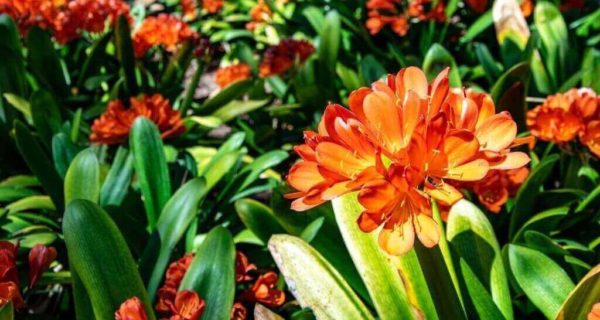Clivia leaves turn yellow typically due to overwatering. Overwatering often leads to root rot. Clivia leaves also turn yellow due to Spider mites/scale infestation. Clivia leaves also turn yellow due to sunburn.
Clivia is grown indoors for its colorful blossoms. Clivia flowers are quite similar to that of Amaryllis because they are of the same family(classification).
Clivia is also called Kaffir lily. Are your Clivia leaves turning yellow? Let’s discuss why this happens and how to fix it!
Overwatered Clivia
Clivia leaves turn yellow when the plant gets more water than it needs. This condition is called overwatering.
Overwatering leads to waterlogged conditions. If Clivia gets exposed to waterlogged conditions for a long time, it leads to root rot.
What does an overwatered Clivia look like?
The leaves of an overwatered Clivia turn yellow and become wilted. Initially, yellow spots are seen on the foliage.
Eventually, if you don’t respond and care well for the plant, the leaves completely turn yellow.
This happens because the plant’s roots can’t absorb water and minerals efficiently, thanks to the waterlogged conditions.
Clivia watering instructions
Follow the below instructions to keep your Clivia from harm’s way.
- The potting mix needs to dry out slightly between the watering sessions.
- Check the potting mix with bare fingers if needed. Water only when the soil is dry up to 2 inches.
- Make sure to use a potting mix that drains excess water efficiently.
- Plant your Clivia in a pot that has drain holes to drain excess water away.
- Water your Cliviva from below to avoid a number of diseases. This method is explained here.
Root rot in Clivia
Prolonged waterlogged conditions lead to root rot in Clivia. Root rot is caused by a fungal pathogen Phytophthora.
Soggy soil favors the growth of the Phytophthora fungus. Infected roots turn brown and mushy.
So, the first thing you want to do to confirm root rot is to check the roots/root ball. Are they white? or are they brown and mushy?
If the roots are brown and mushy, you need to respond quickly and revive the plant.
Treat root rot in Clivia
Follow the below instructions to revive your Clivia that’s infected by root rot.
- Check if the roots are really rotten. Rotten roots are brown and mushy. Stop watering the plant immediately if the roots are brown and mushy.
- Take the plant out from the ground/pot carefully. Wash the infected roots in a solution of Hydrogen Peroxide mixed according to this guide.
- Wash the roots gently and if you think it’s not possible, spray the solution on the infected roots.
- Cut off the infected roots using a pair of pruning shears. Disinfect the pruning shears after doing this.
- Re-plant the Clivia in a new pot with fresh potting mix. Make sure the potting mix drains excess water efficiently.
- Ensure that the new pot has drain holes to drain the excess water away.
- Treat the new pot with appropriate fungicide. Treat the potting mix with some fungicide fortnightly to prevent future infections.
Dormancy in Clivia
Clivia leaves turn yellow in the dormancy period. Clivia goes into dormancy in the winter season. This is a period where the plant survives with the least amount of resources.
Dormancy needs to be observed if you grow the plant indoors. Don’t water your plants for at least 6-8 weeks during their dormancy.
If you are growing the plant outside, bring it indoors before the first freeze.
I advise you to place your Clivia in a place where the temperatures are between 35 and 55F. This is essential if you wanna see blossoms on the plant.
After 8 weeks of dormancy, water your Clivia. You need to increase the watering frequency/amount gradually.
See that the temperature increases gradually up to 60F.
Yellow spots on Clivia leaves
Yellow spots on Clivia are due to Spider mites or Scale insects. These are sap-sucking insects that could damage Cilvia greatly.
Leaves on an affected plant become wilted and distorted. Yellow spots are seen on the uppersides of the foliage.
These insects suck plant sap from the undersides of the leaves. Your plant won’t be bothered if it’s a small infestation.
A large infestation could even kill your Clivia. You may want to hang yellow, sticky cards around your Clivia to identify an infestation early on.
Spider mites’ presence can be confirmed if you see webcasts around your Clivia.
Scale insects are immobile insects that get attached to the stems of Clivia. They suck the plant sap from Clivia.
Control spider mites and scale on Clivia
- Dislodge spider mites by splashing water forcefully on the affected parts of your Clivia using a garden hose.
- Wipe these insects off your plant using a cotton bud dipped in rubbing alcohol.
- You may also spray Neem oil or Insecticidal soap on the affected parts of the Clivia plant.
- You can spray Botanical insecticides to eliminate a pesky pest like scale. This should be the last resort.
Sunburn on Clivia
Clivia leaves also turn yellow if the plant gets direct, bright sunlight for too long. This condition is called ‘Sunburn’.
Too much sunlight not only affects the foliage but also discolors and damages the stem.
Trim off the brown parts of the leaves using a sterilized pair of pruning shears. Disinfect the tool after using it.
In my experience, Clivia burns easily. It should not get the bright afternoon sun. Keep this in mind and plant it in someplace where it gets at least partial shade in the afternoon.
Move the plant to a shadier place in the summer season. You could also help the plant by planting some bigger plants for shade.
One can also install an artificial shade cloth around Clivia to protect the plant from sunburn.
Happy Gardening 🙂

